An Ultra-Thin, Triple-Band, Incident Angle-Insensitive Perfect Metamaterial Absorber
Abstract
:1. Introduction
2. Metamaterial Unit Cell Design Geometry
3. Results and Discussion
3.1. Absorptions Scenario
3.2. Incident Angle Insensitivity
3.3. Equivalent Circuit Analysis
3.4. Electric Field, Magnetic Field, and Surface Current Distribution
3.5. Metamaterial Characteristics
3.6. Array Analysis
4. Validation of CST Results with HFSS Simulation
5. Conclusions
Author Contributions
Funding
Institutional Review Board Statement
Informed Consent Statement
Data Availability Statement
Acknowledgments
Conflicts of Interest
References
- Zheng, H.; Chen, L.; Lee, Y.P. Flexible Metamaterial Absorber with Tailored Bandwidth and High Absorption Performance. Crystals 2022, 12, 182. [Google Scholar] [CrossRef]
- Shen, H.; Liu, C.; Liu, F.; Jin, Y.; Guo, B.; Wei, Z.; Wang, F.; Tan, C.; Huang, X.; Meng, H. Multi-band plasmonic absorber based on hybrid metal-graphene metasurface for refractive index sensing application. Results Phys. 2021, 23, 104020. [Google Scholar] [CrossRef]
- Xiao, S.; Liu, T.; Cheng, L.; Zhou, C.; Jiang, X.; Li, Z.; Xu, C. Tunable anisotropic absorption in hyperbolic metamaterials based on black phosphorous/dielectric multilayer structures. J. Light. Technol. 2019, 37, 3290–3297. [Google Scholar] [CrossRef] [Green Version]
- Halterman, K.; Alidoust, M. Waveguide modes in Weyl semimetals with tilted dirac cones. Opt. Express 2019, 27, 36164–36182. [Google Scholar] [CrossRef] [Green Version]
- Smith, D.R.; Vier, D.C.; Koschny, T.; Soukoulis, C.M. Electromagnetic parameter retrieval from inhomogeneous metamaterials. Phys. Rev. E 2005, 71, 036617. [Google Scholar] [CrossRef] [Green Version]
- Akgol, O.; Altintas, O.; Dalkılınc, E.E.; Unal, E.; Karaaslan, M.; Sabah, C. Metamaterial absorber-based multisensor applications using a meander-line resonator. Opt. Eng. 2017, 56, 087104. [Google Scholar] [CrossRef]
- Wang, Y.; Zhu, D.; Cui, Z.; Hou, L.; Lin, L.; Qu, F.; Liu, X.; Nie, P. All-dielectric terahertz plasmonic metamaterial absorbers and high-sensitivity sensing. ACS Omega 2019, 4, 18645–18652. [Google Scholar] [CrossRef] [Green Version]
- Hossain, M.B.; Faruque, M.R.I.; Alshammari, A.S.; Islam, M.T. Wide bandwidth enriched symmetric hexagonal split ring resonator based triple band negative permittivity metamaterial for satellite and Wi-Fi applications. Results Phys. 2022, 37, 105511. [Google Scholar] [CrossRef]
- Singh, R.K.; Gupta, A. A wrenched-square shaped polarization independent and wide angle stable ultra-thin metamaterial absorber for S-band, X-band and Ku-band applications. AEU-Int. J. Electron. Commun. 2021, 132, 153648. [Google Scholar] [CrossRef]
- Abdulkarim, Y.I.; Deng, L.; Karaaslan, M.; Unal, E. Determination of the liquid chemicals depending on the electrical characteristics by using metamaterial absorber-based sensor. Chem. Phys. Lett. 2019, 732, 136655. [Google Scholar] [CrossRef]
- Hossain, M.I.; Faruque, M.R.I.; Islam, M.T.; Ullah, M.H. A new wide-band double-negative metamaterial for C-and S-band applications. Materials 2014, 8, 57–71. [Google Scholar] [CrossRef] [PubMed] [Green Version]
- Islam, S.S.; Faruque, M.R.I.; Islam, M.T. A near zero refractive index metamaterial for electromagnetic invisibility cloaking operation. Materials 2015, 8, 4790–4804. [Google Scholar] [CrossRef] [PubMed]
- Kang, Y.; Wang, J.; Liu, H. A Dual-Band Polarization Insensitive Metamaterial Absorber with a Single Square Metallic Patch for Sensing Application. Plasmonics 2022, 17, 449–456. [Google Scholar] [CrossRef]
- Abdulkarim, Y.I.; Deng, L.; Luo, H.; Huang, S.; Karaaslan, M.; Altıntaş, O.; Bakır, M.; Muhammadsharif, F.F.; Awl, H.N.; Sabah, C.; et al. Design and study of a metamaterial-based sensor for the application of liquid chemicals detection. J. Mater. Res. Technol. 2022, 9, 10291–10304. [Google Scholar] [CrossRef]
- Dincer, F. Electromagnetic energy harvesting application based on tunable perfect metamaterial absorber. J. Electromagn. Waves Appl. 2015, 29, 2444–2453. [Google Scholar] [CrossRef]
- Hossain, M.B.; Faruque, M.R.I.; Islam, M.T.; Singh, M.; Jusoh, M. Triple band microwave metamaterial absorber based on double E-shaped symmetric split ring resonators for EMI shielding and stealth applications. J. Mater. Res. Technol. 2022, 18, 1653–1668. [Google Scholar] [CrossRef]
- Wang, B.Y.; Liu, S.B.; Bian, B.R.; Mao, Z.W.; Liu, X.C.; Ma, B.; Chen, L. A novel ultrathin and broadband microwave metamaterial absorber. J. Appl. Phys. 2014, 116, 094504. [Google Scholar] [CrossRef]
- Chen, F.; Cheng, Y.; Luo, H. A broadband tunable terahertz metamaterial absorber based on single-layer complementary gammadion-shaped graphene. Materials 2020, 13, 860. [Google Scholar] [CrossRef] [Green Version]
- Ning, J.; Dong, S.; Luo, X.; Chen, K.; Zhao, J.; Jiang, T.; Feng, Y. Ultra-broadband microwave absorption by ultra-thin metamaterial with stepped structure induced multi-resonances. Results Phys. 2020, 18, 103320. [Google Scholar] [CrossRef]
- Numan, A.B.; Sharawi, M.S. Extraction of material parameters for metamaterials using a full-wave simulator. IEEE Antennas Propag. Mag. 2013, 55, 202–211. [Google Scholar] [CrossRef]
- Ding, F.; Cui, Y.; Ge, X.; Jin, Y.; He, S. Ultra-broadband microwave metamaterial absorber. Appl. Phys. Lett. 2012, 100, 103506. [Google Scholar] [CrossRef] [Green Version]
- Landy, N.I.; Sajuyigbe, S.; Mock, J.J.; Smith, D.R.; Padilla, W.J. Perfect metamaterial absorber. Phys. Rev. Lett. 2008, 100, 207402. [Google Scholar] [CrossRef] [PubMed]
- Amiri, M.; Tofigh, F.; Shariati, N.; Lipman, J.; Abolhasan, M. Wide-angle metamaterial absorber with highly insensitive absorption for TE and TM modes. Sci. Rep. 2020, 10, 13638. [Google Scholar] [CrossRef] [PubMed]
- Al-Badri, K.S.L. Microwave metamaterial for broad-band perfect absorber applications. Mater. Today Proc. 2021, 42, 2835–2839. [Google Scholar] [CrossRef]
- Nguyen, T.Q.H.; Nguyen, T.K.T.; Cao, T.N.; Nguyen, H.; Bach, L.G. Numerical study of a broadband metamaterial absorber using a single split circle ring and lumped resistors for X-band applications. AIP Adv. 2020, 10, 035326. [Google Scholar] [CrossRef]
- Afsar, M.S.U.; Faruque, M.R.I.; Hossain, M.B. Holy cross-moon shaped dual band perfect metamaterial absorber for C-band application. Mater. Today Commun. 2022, 33, 104309. [Google Scholar] [CrossRef]
- Wang, B.X.; He, Y.; Lou, P.; Xing, W. Design of a dual-band terahertz metamaterial absorber using two identical square patches for sensing application. Nanoscale Adv. 2020, 2, 763–769. [Google Scholar] [CrossRef] [Green Version]
- Al-Badri, K.S.L. Very high Q-factor based on g-shaped resonator type metamaterial absorber. Ibn AL-Haitham J. Pure Appl. Sci. 2018, 87, 159–166. [Google Scholar] [CrossRef]
- Elakkiya, A.; Radha, S.; Sreeja, B.S.; Manikandan, E. An Ultrathin Microwave Metamaterial Absorber for C, X, and Ku Band Applications. J. Electron. Mater. 2021, 50, 7275–7282. [Google Scholar] [CrossRef]
- Wang, B.X.; Zhai, X.; Wang, G.Z.; Huang, W.Q.; Wang, L.L. A novel dual-band terahertz metamaterial absorber for a sensor application. J. Appl. Phys. 2015, 117, 014504. [Google Scholar] [CrossRef]
- Ramachandran, T.; Faruque, M.R.I.; Ahamed, E. Composite circular split ring resonator (CSRR)-based left-handed metamaterial for C-and Ku-band application. Results Phys. 2019, 14, 102435. [Google Scholar] [CrossRef]
- Hossain, M.J.; Faruque, M.R.I.; Islam, M.T. Perfect metamaterial absorber with high fractional bandwidth for solar energy harvesting. PLoS ONE 2018, 13, e0207314. [Google Scholar] [CrossRef] [Green Version]
- Ji, S.; Jiang, C.; Zhao, J.; Zhang, X.; He, Q. Design of a polarization-insensitive triple-band metamaterial absorber. Opt. Commun. 2019, 432, 65–70. [Google Scholar] [CrossRef]
- Liang, Y.; Lin, H.; Lin, S.; Wu, J.; Li, W.; Meng, F.; Yang, Y.; Huang, X.; Jia, B.; Kivshar, Y. Hybrid anisotropic plasmonic metasurfaces with multiple resonances of focused light beams. Nano Lett. 2021, 21, 8917–8923. [Google Scholar] [CrossRef] [PubMed]
- Liu, G.; Liu, Y.; Liu, X.; Chen, J.; Fu, G.; Liu, Z. Large-area, low-cost, ultra broadband, infrared perfect absorbers by coupled plasmonis-photonic, Micro-cavities. Solar Energy Materials and Solar Cells. November 2018, 186, 142–148. [Google Scholar]
- Ramachandran, T.; Faruque, M.R.I.; Islam, M.T.; Khandaker, M.U.; Alqahtani, A.; Bradley, D.A. Development and Analysis of Coding and Tailored Metamaterial for Terahertz Frequency Applications. Materials 2022, 15, 2777. [Google Scholar] [CrossRef]
- Sarkhel, A.; Chaudhuri, S.R.B. Compact Quad-band Polarization Insensitive Ultrathin Metamaterial Absorber with Wide angle Stability. IEEE Antennas Wirel. Propag. Lett. 2017, 16, 3240–3244. [Google Scholar] [CrossRef]
- Tamim, A.M.; Hasan, M.M.; Faruque, M.R.I.; Islam, M.T.; Nebhen, J. Polarization-independent symmetrical digital metasurface absorber. Results Phys. 2021, 24, 103985. [Google Scholar] [CrossRef]
- Al-Badri, K.S.L.; Alwan, Y.S.; Khalaf, M.F. Ultra-thin dual-band perfect metamaterials absorber for microwave applications. Mater. Today Proc. 2021, 42, 2164–2168. [Google Scholar] [CrossRef]
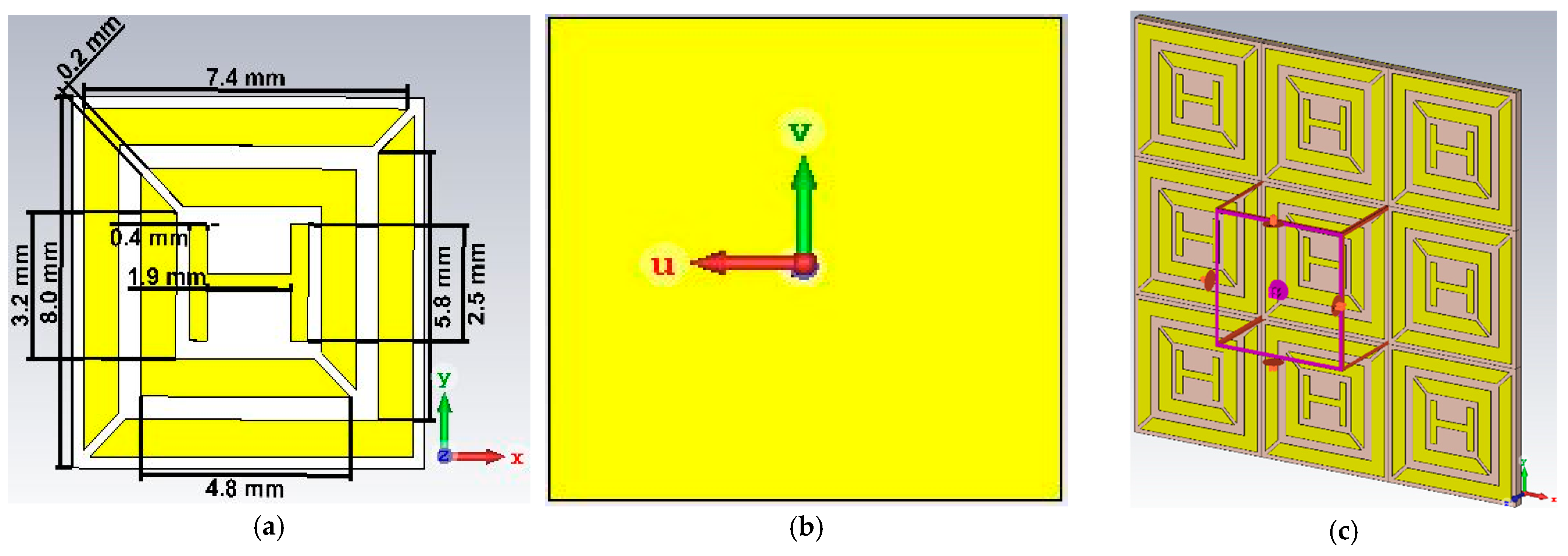

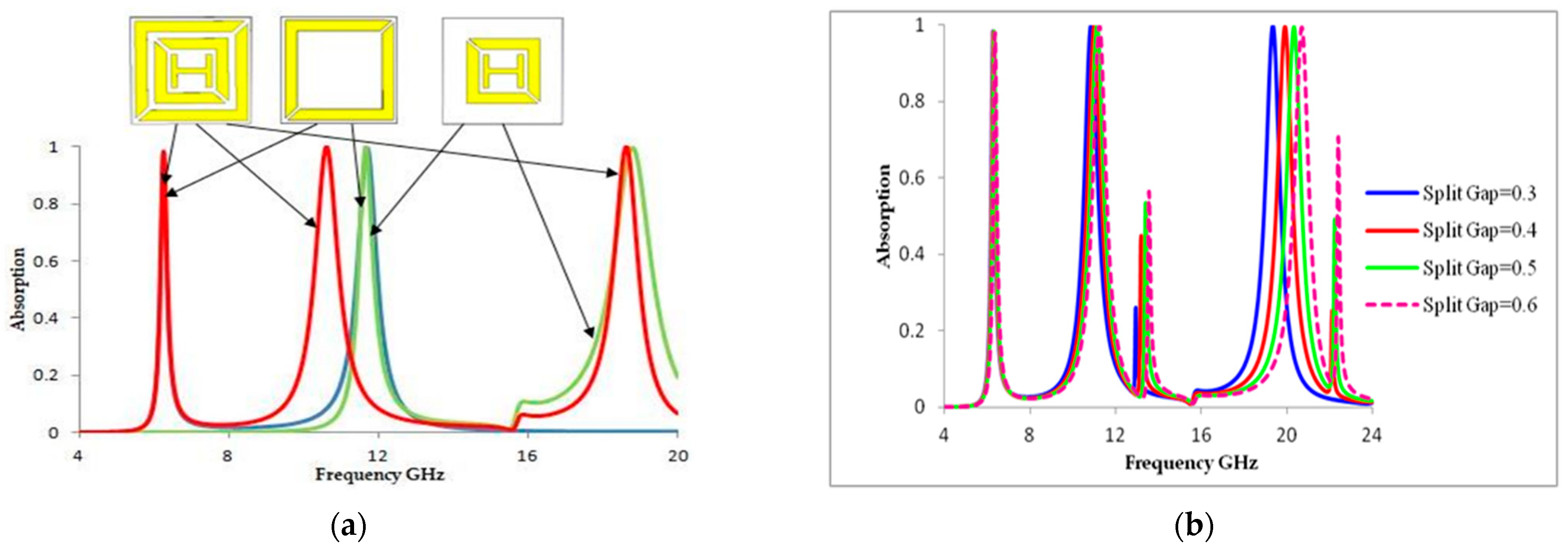


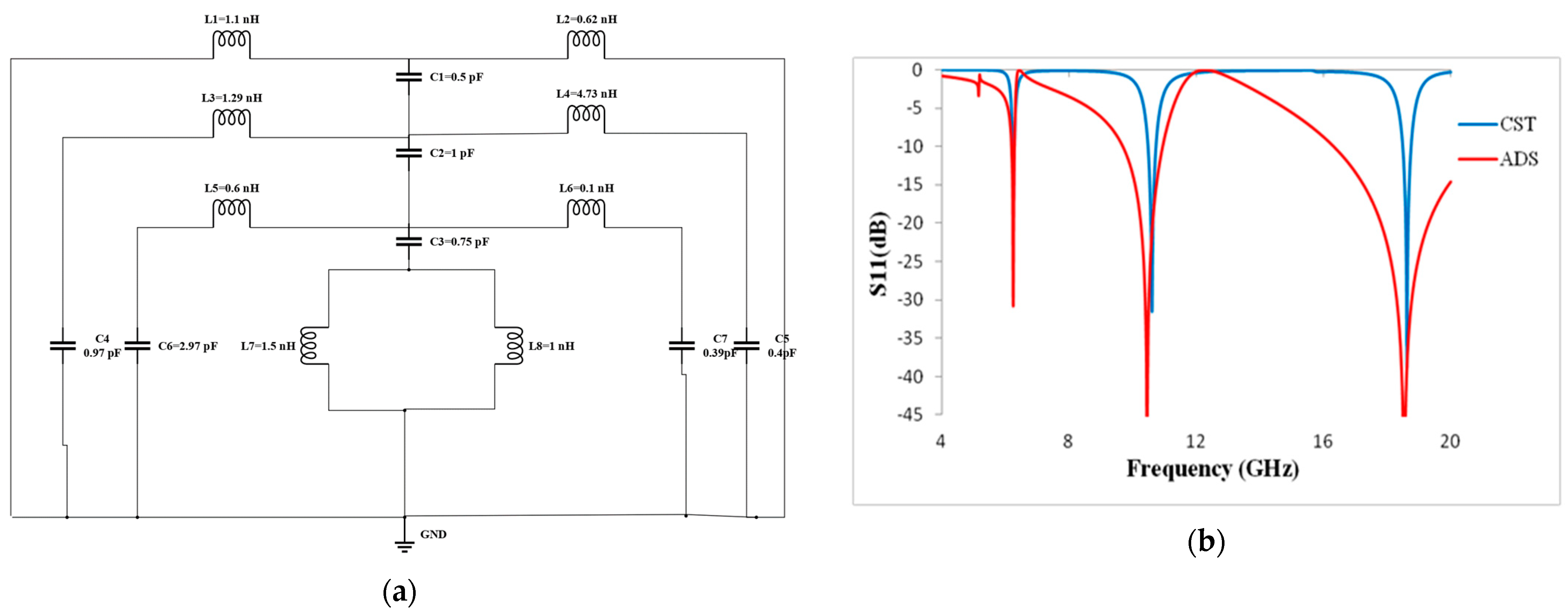
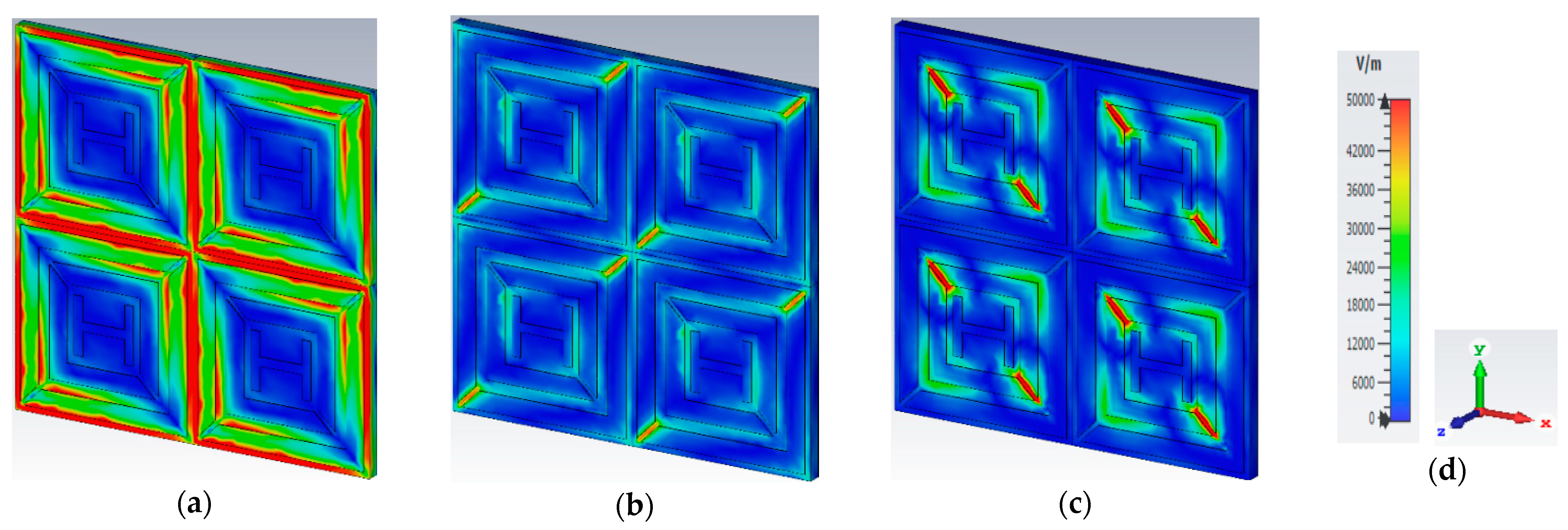
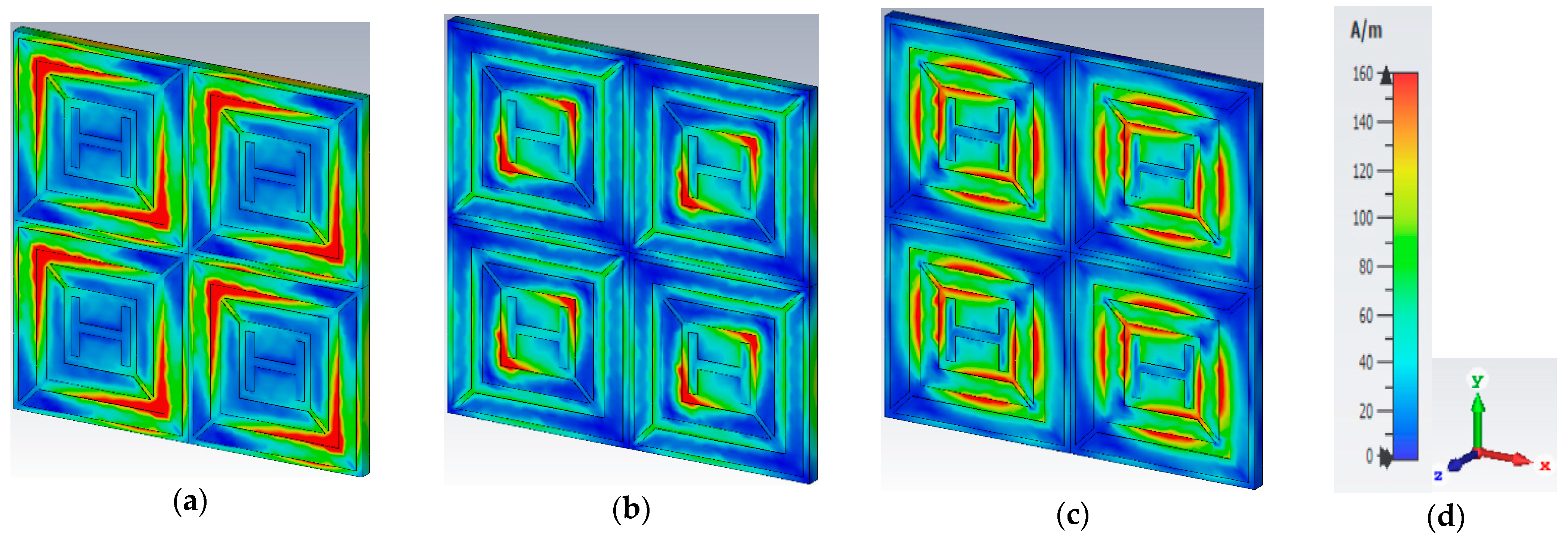

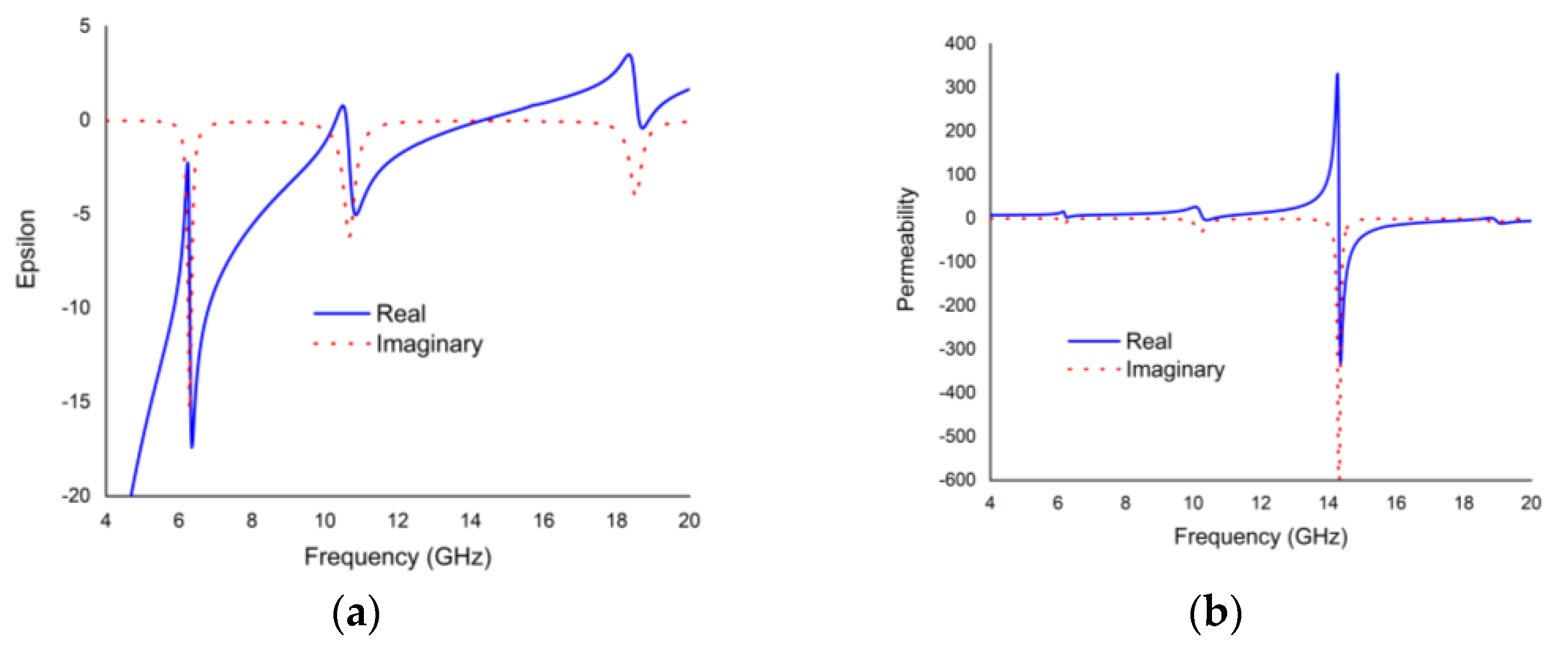



| Frequency (GHz) | FWHM | Q Factor | fU; fL | RAB |
|---|---|---|---|---|
| 6.24 | 0.1 | 62.4 | 6.3; 6.1 | 32% |
| 10.608 | 0.6 | 17.68 | 10.7; 10.4 | 28% |
| 18.624 | 0.7 | 26.61 | 18.7; 18.3 | 21% |
| Frequency (GHz) | FWHM | Q Factor | fU; fL | RAB |
|---|---|---|---|---|
| 6.24 | 0.1 | 62.4 | 6.3; 6.1 | 32% |
| 10.608 | 0.6 | 17.68 | 10.7; 10.4 | 28% |
| 18.625 | 0.6 | 31.04 | 18.8; 18.4 | 21% |
| Reference | Size (mm) | Frequency Range (GHz) | Design | Absorption (%) | Other Factors |
|---|---|---|---|---|---|
| [9] | 10.4 × 10.4 | 3.2, 5.32, 11.15, 16.73 | Four-fold symmetry | 95.75%,95.93%, 97.69%, 95.64% | Incident angle 0° to 45° and FWHM of 90, 220, 410, and 700 MHz |
| [17] | 8.25 × 8.25 | 8.85, 14.17 | A metallic pentagon patch | 90% and 90% | FWHM 57.3% |
| [21] | 11 × 11 | 7.8–14.7 | Quadrangular frustum pyramids | Above 90% | RAB 61.6% and polarization-independent |
| [28] | 34.036 × 34.036 | 2.7, 3.26, 4.05 | G-shape resonator | 60%, 91.5%, 70.3% | Q-factor 271 at 3.26 GHz |
| [39] | 10 × 10 | 3.68, 8.58, 10.17, 14.93 | Conductive cross dipoles | 96.15%, 99.1%, 99.75%, 98.75% | Polarization-insensitive (0°, 15°, 30°, 45°, 60°) |
| Proposed design | 8 × 8 | 6.24(C-band), 10.608(X-band), 18.624(K-band) | Two metallic square patches with H-shaped structure | 97.8%, 99.9%, 99.9% | Incident angle-insensitive (0°, 15°, 30°, 45°); Q-factors of 62.4, 17.68, 26.61; and RAB calculated as 32%, 28%, and 21% |
Disclaimer/Publisher’s Note: The statements, opinions and data contained in all publications are solely those of the individual author(s) and contributor(s) and not of MDPI and/or the editor(s). MDPI and/or the editor(s) disclaim responsibility for any injury to people or property resulting from any ideas, methods, instructions or products referred to in the content. |
© 2023 by the authors. Licensee MDPI, Basel, Switzerland. This article is an open access article distributed under the terms and conditions of the Creative Commons Attribution (CC BY) license (https://creativecommons.org/licenses/by/4.0/).
Share and Cite
Jahan, M.I.; Faruque, M.R.I.; Hossain, M.B.; Abdullah, S. An Ultra-Thin, Triple-Band, Incident Angle-Insensitive Perfect Metamaterial Absorber. Materials 2023, 16, 1623. https://doi.org/10.3390/ma16041623
Jahan MI, Faruque MRI, Hossain MB, Abdullah S. An Ultra-Thin, Triple-Band, Incident Angle-Insensitive Perfect Metamaterial Absorber. Materials. 2023; 16(4):1623. https://doi.org/10.3390/ma16041623
Chicago/Turabian StyleJahan, MST Ishrat, Mohammad Rashed Iqbal Faruque, Md Bellal Hossain, and Sabirin Abdullah. 2023. "An Ultra-Thin, Triple-Band, Incident Angle-Insensitive Perfect Metamaterial Absorber" Materials 16, no. 4: 1623. https://doi.org/10.3390/ma16041623





